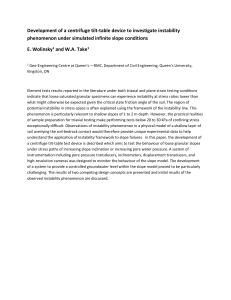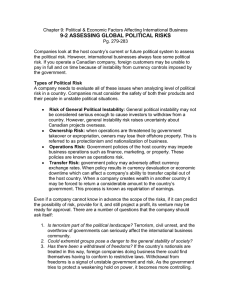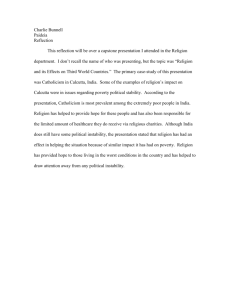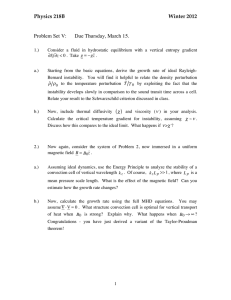URBAN INSTITUTE The Negative Effects of Instability on Child Development
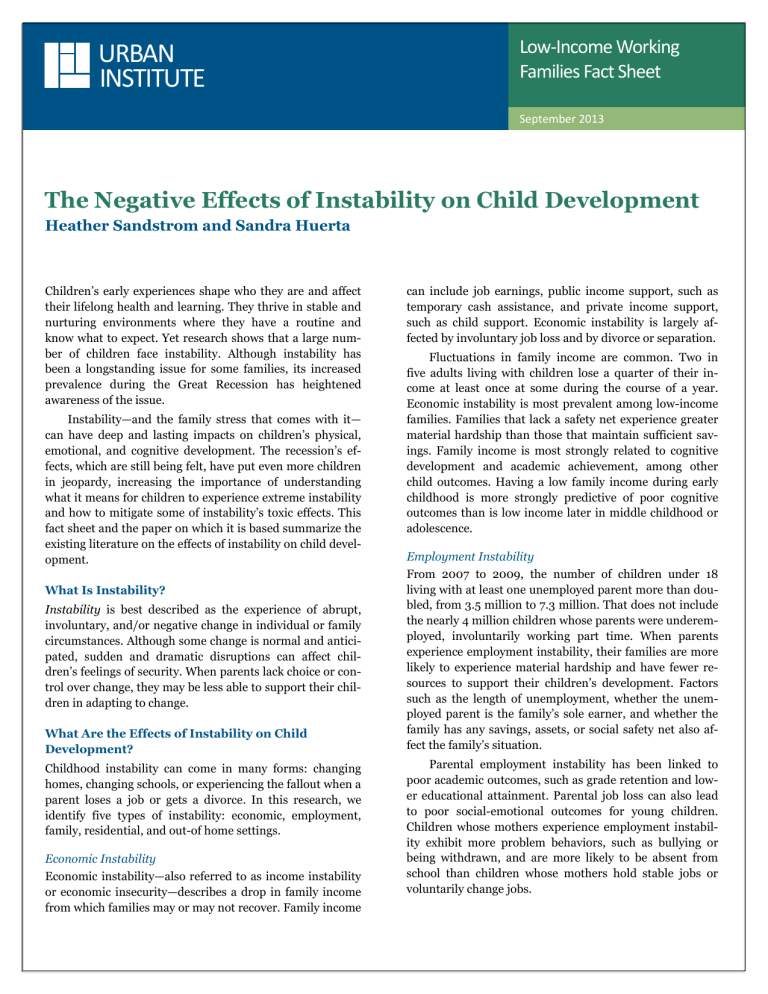
URBAN
INSTITUTE
Low ‐ Income Working
Families Fact Sheet
September
2013
The Negative Effects of Instability on Child Development
Heather Sandstrom and Sandra Huerta
Children’s early experiences shape who they are and affect their lifelong health and learning. They thrive in stable and nurturing environments where they have a routine and know what to expect. Yet research shows that a large number of children face instability. Although instability has been a longstanding issue for some families, its increased prevalence during the Great Recession has heightened awareness of the issue.
Instability—and the family stress that comes with it— can have deep and lasting impacts on children’s physical, emotional, and cognitive development. The recession’s effects, which are still being felt, have put even more children in jeopardy, increasing the importance of understanding what it means for children to experience extreme instability and how to mitigate some of instability’s toxic effects. This fact sheet and the paper on which it is based summarize the existing literature on the effects of instability on child development.
What Is Instability?
Instability is best described as the experience of abrupt, involuntary, and/or negative change in individual or family circumstances. Although some change is normal and anticipated, sudden and dramatic disruptions can affect children’s feelings of security. When parents lack choice or control over change, they may be less able to support their children in adapting to change.
What Are the Effects of Instability on Child
Development?
Childhood instability can come in many forms: changing homes, changing schools, or experiencing the fallout when a parent loses a job or gets a divorce. In this research, we identify five types of instability: economic, employment, family, residential, and out-of home settings.
Economic Instability
Economic instability—also referred to as income instability or economic insecurity—describes a drop in family income from which families may or may not recover. Family income
can include job earnings, public income support, such as temporary cash assistance, and private income support, such as child support. Economic instability is largely affected by involuntary job loss and by divorce or separation.
Fluctuations in family income are common. Two in five adults living with children lose a quarter of their income at least once at some during the course of a year.
Economic instability is most prevalent among low-income families. Families that lack a safety net experience greater material hardship than those that maintain sufficient savings. Family income is most strongly related to cognitive development and academic achievement, among other child outcomes. Having a low family income during early childhood is more strongly predictive of poor cognitive outcomes than is low income later in middle childhood or adolescence.
Employment Instability
From 2007 to 2009, the number of children under 18 living with at least one unemployed parent more than doubled, from 3.5 million to 7.3 million. That does not include the nearly 4 million children whose parents were underemployed, involuntarily working part time. When parents experience employment instability, their families are more likely to experience material hardship and have fewer resources to support their children’s development. Factors such as the length of unemployment, whether the unemployed parent is the family’s sole earner, and whether the family has any savings, assets, or social safety net also affect the family’s situation.
Parental employment instability has been linked to poor academic outcomes, such as grade retention and lower educational attainment. Parental job loss can also lead to poor social-emotional outcomes for young children.
Children whose mothers experience employment instability exhibit more problem behaviors, such as bullying or being withdrawn, and are more likely to be absent from school than children whose mothers hold stable jobs or voluntarily change jobs.
URBAN
INSTITUTE
Low ‐ Income
Working Families
2
Family Instability
According to recent estimates, between birth and fourth grade, more than one-third of children see their parents marry, remarry, separate, or start or end a cohabiting union. Family instability is positively linked to problem behaviors and some academic outcomes, even at early ages.
Family transitions that occur prior to age 6 and in adolescence appear to have the strongest effects. Young children need constant caregivers with whom they can form secure attachments. Adolescents need parental support, role models, and continuity of residence and schools to succeed.
Children’s problem behaviors further increase with multiple changes in family structure. Children demonstrate more negative behaviors when they lack the emotional and material support at home that they need to handle a family transition.
Residential Instability
In 2012, 36.5 million people (age one and older), or 12 percent of the population, changed residences in the United
States within the prior year. Residential moves can be very stressful for children across different ages. Chronic residential instability early in life has negative impacts on children’s mental health and vocabulary development. Instability during the elementary school years can lead to lower quality homes and neighborhoods and less parent involvement, and children’s academic and social outcomes may be indirectly affected by these changes. Adolescents experiencing multiple moves show difficulty adapting, express negative social behaviors, and have a greater chance of dropping out of high school.
Instability in Out-of-Home Contexts: Child Care and
School
Nearly 40 percent of children who start child care in their first year of life experience at least one change in care arrangements in their first 15 months. National longitudinal surveys report the average arrangement lasts 12 months, although recent studies of low-income working families and families receiving child care subsidies report much shorter durations. For infants, changes in child care arrangements can lead to poor attachment with providers and problem behaviors. For preschoolers, early care and education settings support the development of foundational school readiness skills; changes in care settings can disrupt the continuity of learning.
According to national estimates, one-third of 4th graders, one-fifth of 8th graders, and one-tenth of 12th graders have changed schools at least once in the previous two years. Changes in schools, particularly during the academic year, can impede children’s academic progress and decrease social competence. School mobility has the strongest effect during early elementary and high school, with multiple school transfers leading to worse effects. Lowincome and minority children are more likely to transfer schools than their more economically advantaged and nonminority peers.
What Are the Implications for Policy and Practice?
This research has important policy implications for programs that serve and support families with children.
Although parents are primary in assuring their children’s well-being and healthy development, a broad range of government programs also play an important role, especially for children in low-income families. Safety net programs provide financial assistance to families in the form of cash payments or subsidized housing, child care, or food, all of which help alleviate the immediate effects of instability.
These programs might be able to do more to stabilize the situation for children by considering whether any policies or administrative practices inadvertently increase instability. The more hoops there are to jump through, the less likely families experiencing instability will be able to handle applying for and maintaining needed safety net programs. Simplified reporting procedures, longer eligibility periods, and a single, centralized eligibility process for multiple programs would be a start to helping families in need stay covered. Specifically among low-income families receiving child care assistance, longer job search periods for unemployed parents and higher income thresholds for continuous recipients might reduce child care instability.
Research findings also stress the need to implement policies and programs that assist families experiencing residential instability, including increased access to more sustainable housing options, expanded efforts to promote school continuity for movers, and additional support or resources in schools that have a disproportionate numbers of movers. Having systems and policies in place in early childhood programs and schools to identify families who are experiencing multiple changes is one strategy for targeting extra services and case management.
Research points to the underlying role of parenting, parental mental health, and the home environment in providing the stability and support young children need.
Positive parenting may also buffer children from instabil-
URBAN
INSTITUTE ity. When parents successfully cope and adapt to stressful life changes, and support their children through these changes, the impact of adverse experiences on children may be lessened, and potentially insignificant. Well-designed, two-generational intervention programs aimed at supporting positive parenting, reducing parental and childhood stress, and strengthening family coping strategies can ease the impact of instability on children.
Low ‐ Income Working
Families Fact Sheet
September
2013
Related Urban Institute Reports
Acs, Gregory and Austin Nichols. 2010. “America Insecure: Changes in the Economic Security of American Families.” Washington, DC: The
Urban Institute.
Adams, Gina and Monica Rohacek. 2010. “Child Care Instability: Definitions, Context and Policy Implications.” Washington DC: The
Urban Institute.
Dubay, Lisa and Elena Zarabozo. 2013. “Economic Stress and Instability in Children’s Lives: Changes Over the Course of the Great Recession.” Washington, DC: The Urban Institute.
Figlio, David, Ashlyn A. Nelson and Stephen L. Ross. 2010. “Do Children Lose More than a Home? The Effects of Foreclosure on Children’s Education Outcomes.” Washington, DC: The Urban Institute.
Isaacs, Julia B. 2013. “Unemployment from a Child’s Perspective.”
Washington, DC: First Focus and The Urban Institute.
McKernan, Signe-Mary, Caroline Ratcliffe, and Katie Vinopal. 2009.
“Do Assets Help Families Cope with Adverse Events?” Washington,
DC: The Urban Institute.
Mills, Gregory B. and Joe Amick. 2010. “Can Savings Help Overcome
Income Instability?” Washington, DC: The Urban Institute.
Nichols, Austin. 2013. “Explaining Changes in Child Poverty Over the
Past Four Decades.” Washington, DC: The Urban Institute.
Zedlewski, Sheila and Austin Nichols. 2012. “What Happens to Families’ Income and Poverty after Unemployment?” Washington, DC:
The Urban Institute.
This fact sheet is part of the Urban Institute’s Low-Income Working Families project, a multiyear effort that focuses on the private- and public-sector contexts for families’ success or failure. Both contexts offer opportunities for better helping families meet their needs. The Low-Income Working
Families project is currently supported by the Annie E. Casey Foundation.
For more information, please see the full report “The Negative Effects of Instability on Child Development: A Research Synthesis” at www.urban.org.
Copyright © September 2013. The Urban Institute. The views expressed are those of the author and do not necessarily represent those of the Urban
Institute, its board, its sponsors, or other authors in this series. Permission is granted for reproduction of this document, with attribution to the
Urban Institute.
3
![[These nine clues] are noteworthy not so much because they foretell](http://s3.studylib.net/store/data/007474937_1-e53aa8c533cc905a5dc2eeb5aef2d7bb-300x300.png)
